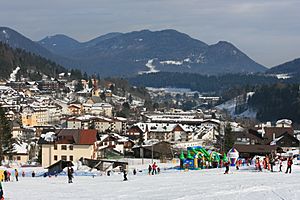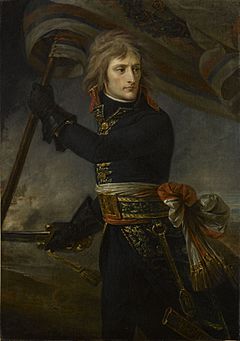Battle of Tarvis (1797) facts for kids
Quick facts for kids Battle of Tarvis (1797) |
|||||||
|---|---|---|---|---|---|---|---|
| Part of the War of the First Coalition | |||||||
 The photo shows the terrain near Tarvisio. |
|||||||
|
|||||||
| Belligerents | |||||||
| Commanders and leaders | |||||||
| Units involved | |||||||
| Strength | |||||||
| 11,000 | 8,000 | ||||||
| Casualties and losses | |||||||
| 1,200 | 4,500, 25 guns 400–500 wagons |
||||||
The Battle of Tarvis took place from March 21 to 23, 1797, near a town called Tarvisio in northeastern Italy. This battle was one of the last big fights before the end of the War of the First Coalition. In this battle, three groups of soldiers from the First French Republic, led by Napoleon Bonaparte, attacked the retreating Austrian army. The Austrian army was commanded by Archduke Charles, Duke of Teschen.
Over three days of intense fighting, French divisions led by generals André Masséna, Jean Joseph Guieu, and Jean-Mathieu-Philibert Sérurier managed to block the important Tarvis Pass. They captured about 3,500 Austrian soldiers, including their leader Adam Bajalics von Bajahaza. This battle was part of the larger French Revolutionary Wars.
After Napoleon captured the fortress of Mantua in early 1797, he secured his southern side by defeating the army of the Papal States. With new soldiers joining him from the Rhine front, Napoleon was determined to push the Austrian army out of northeastern Italy. His attack began in March. One part of his army, led by Barthélemy Catherine Joubert, moved through the County of Tyrol. Napoleon's main army pushed eastward.
The main French army quickly forced the Archduke's forces to retreat. Meanwhile, Joubert fought against Wilhelm Lothar Maria von Kerpen in Tyrol. Archduke Charles tried to hold the Tarvis Pass against the French by sending three groups of reinforcements. However, these groups found the pass already held by Masséna's French forces. Many Austrian soldiers fought their way out, but the last group was trapped by three French divisions coming from different directions and had to surrender. This victory allowed the French to advance to within about 120 kilometers (75 miles) of Vienna, the Austrian capital. In mid-April, Napoleon suggested a peace agreement, and the Austrians agreed to the Preliminaries of Leoben. Most of these terms were later confirmed by the Treaty of Campo Formio in October 1797, which finally ended the long war.
Contents
Background to the Battle
The Fall of Mantua
On February 2, 1797, the Siege of Mantua came to an end. The Austrian commander, Dagobert Sigmund von Wurmser, surrendered the fortress of Mantua to the French. As a sign of respect for his strong defense, Wurmser, his officers, and 700 soldiers were allowed to leave freely. About 20,000 other Austrian soldiers were released, promising not to fight France again until they were officially exchanged for French prisoners. The siege was very costly for the Austrians, with many soldiers killed, wounded, or dying from illness. The French captured many cannons and recovered some of their own guns that had been lost earlier.
General of Division Napoleon Bonaparte was not there for the surrender. He had left a few days earlier to continue the war against the Papal States. Following Napoleon's orders, General Jean-Mathieu-Philibert Sérurier did not change the French surrender terms. Wurmser eventually agreed to Napoleon's conditions. The disarmed Austrian soldiers marched out of Mantua over several days in early February.
French Attacks Begin
While Mantua was surrendering, other important events were happening. On February 3, a French force of 9,000 men, led by General Claude Perrin Victor, defeated a 7,000-strong army from the Papal States. This happened in the Battle of Faenza. The French lost only 100 men, while the Papal States lost many more and had 1,200 soldiers captured. On February 9, the Papal States' garrison in Ancona surrendered to Victor. Soon after, Napoleon forced the Pope to sign the Treaty of Tolentino, making the Papal States pay a large sum of money to France.
In 1796, the French government had sent most of its new soldiers to fight in Germany. However, after not much success there, they decided to send more troops to Italy. Generals Jean-Baptiste Bernadotte and Antoine Guillaume Delmas were moved to the Italian front with their soldiers.
The new Austrian commander in Italy, Archduke Charles, Duke of Teschen, had about 50,000 soldiers. But these troops were spread out over a very wide area. Napoleon decided to attack Charles before the Austrians were fully ready. Napoleon had 60,000 men and planned to attack through Friuli with two-thirds of them. He placed General Barthélemy Catherine Joubert with about 20,000 soldiers to protect the County of Tyrol from any possible Austrian attack. If there was no threat, Joubert was ordered to meet Napoleon in the Drava River valley.
With General Pierre Augereau away, General Jean Joseph Guieu took command of his division. Generals André Masséna, Bernadotte, and Sérurier also marched with Napoleon's main army. At the end of February, the French advance began by crossing the Brenta River. Bad weather caused a short break in fighting. But on March 10, the French pushed forward again in two groups. Napoleon led 32,000 soldiers through Sacile, heading for Valvasone. Masséna and 11,000 men protected the left side of the army. Charles placed his main force between Spilimbergo and San Vito al Tagliamento. On March 14, Masséna fought a small group of Austrians led by Franz Joseph, Marquis de Lusignan.
On March 16, 1797, the divisions of Guieu and Bernadotte attacked across the Tagliamento River, protected by artillery fire. In the Battle of Valvasone, the French caused 700 casualties for the Austrians and captured six cannons. The next day, Bernadotte had a big success at Gradisca d'Isonzo. He cut off an enemy group of 2,500 men and forced them to surrender. Many Austrian soldiers, 10 cannons, and 8 flags were captured.
Meanwhile, about 300 kilometers (186 miles) to the west, Joubert and 18,000 men fought against Wilhelm Lothar Maria von Kerpen's 12,000 troops. This happened on March 20 at St. Michael, near Salorno, Italy. Joubert's troops defeated their opponents, causing 300 killed and wounded and capturing 3,500 Austrians. The French lost 200 killed and wounded.
The Battle of Tarvis
As General Masséna pushed towards Tarvisio, driving the Austrian General Lusignan before him, Archduke Charles sent three divisions to hold the important mountain pass. However, as these Austrian groups arrived, they found themselves caught between Masséna's forces and Napoleon's other divisions, which were attacking them from behind.
In the first clash on March 21, Masséna's advance guard pushed Joseph Ocskay von Ocsko's Austrian soldiers out of Tarvis. This blocked the Austrians' escape route. Later that day, another Austrian group led by Charles Philippe Vinchant de Gontroeul arrived and pushed the French out of Tarvis. Masséna launched a strong attack on March 22, taking the town back from Gontroeul and forcing him to retreat towards Villach.
This left Adam Bajalics von Bajahaza's Austrian group stuck on the wrong side of the pass. Bajalics and Samuel Köblös de Nagy-Varád fought on March 22 against the French divisions of Masséna, Guieu, and Sérurier. The next day, they had to surrender. The French captured 4,000 Austrian soldiers, 25 cannons, and 500 wagons. Other reports say 3,500 Austrians were captured, along with 25 guns and 400 vehicles. In these battles, the French lost about 1,200 soldiers, while the Austrians had 1,000 killed and wounded.
Aftermath of the Battle
While Bernadotte chased the part of Charles's army that retreated towards Ljubljana, General Charles Dugua took control of the port of Trieste with his cavalry. As his supply lines became longer, Napoleon set up a new main base at Palmanova. To protect his left side, Napoleon ordered Joubert to secure Brixen. Around this time, General Louis François Jean Chabot took over Sérurier's division because Sérurier was ill. On March 29, the French divisions of Masséna, Guieu, and Chabot captured Klagenfurt.
Napoleon had too few soldiers for a big attack. So, he moved his main base to Klagenfurt and ordered the separate groups of Joubert, Bernadotte, and Victor (from the Papal States) to join him there. General Louis Friant was assigned to hold Trieste with 1,500 soldiers. On March 31, Napoleon sent a letter to Archduke Charles asking for a ceasefire. He hoped this would give time for General Jean Victor Marie Moreau's attack in Germany to begin. To make Charles think the French were very strong, Napoleon pushed his men forward. On April 7, they captured Leoben, which was only about 120 kilometers (75 miles) from Vienna. On that day, the Austrians agreed to stop fighting for five days.
After getting another five-day truce on April 13, Napoleon suggested starting peace talks on April 16, even though he didn't have the official power to do so. The Austrians knew that the French were about to launch a big attack on the Rhine River. So, they signed the Preliminaries of Leoben on April 18. Most of the terms of this agreement were later confirmed by the Treaty of Campo Formio on October 17, 1797. After the ceasefire, there was some fighting on the Rhine that didn't change much. On April 18, a French army under General Lazare Hoche defeated Austrian forces at the Battle of Neuwied. Moreau's army finally attacked on April 20 and 21, pushing back Austrian troops in the Battle of Diersheim.
During the fighting at Tarvis, Joubert's group of soldiers continued to advance. The French general pushed back an attack by Johann Ludwig Alexius von Loudon at Neumarkt on March 21. Joubert left Delmas's 5,000-man division to protect his supply line. He then moved forward to Klausen, where he again defeated Kerpen on March 22. The Austrian general retreated northeast to Mittenwald, where he was beaten again on March 28 and pushed out of Sterzing. With many local people from Tyrol joining militias to fight the French, Joubert had to fall back to Brixen. On March 31, Kerpen attacked the French at Brixen but couldn't force them out. After getting more soldiers, making his force 12,000 men, Kerpen attacked Brixen again on April 2 but still failed. However, under constant pressure, Delmas pulled back from Bolzano on April 4. The next day, Joubert set out for Villach to meet Napoleon. After continuous small fights with the Tyroleans, his group reached Villach on May 8, well after the Leoben agreement was signed. During Joubert's campaign, the French might have lost as many as 8,000 men.
Images for kids







